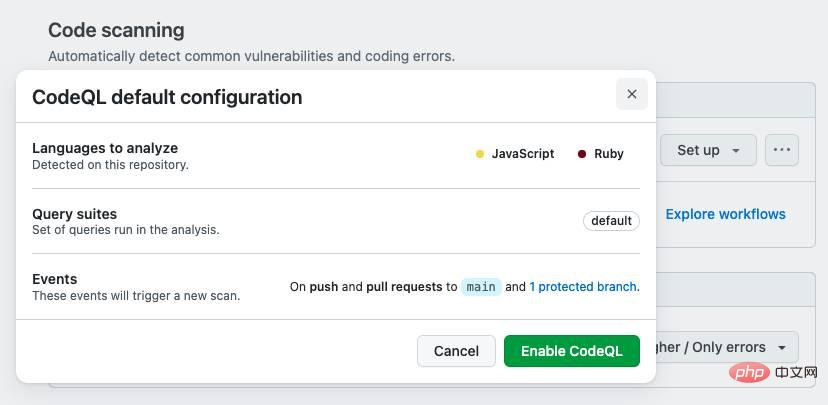GitHub offers new 'default settings' option for code scanning
GitHub There is a new code scanning settings option called "Default Settings" which allows developers to automatically Enable code scanning on the library.
"The default settings simplify the process of starting code scanning on Python, JavaScript, and Ruby repositories," explained Walker Chabbott, product marketing manager at GitHub, in a blog post announcing the option. "You can now enable code scanning with just a few clicks without the need for a .yaml file, helping open source developers and enterprises simplify code scanning setup so they can protect more software. Once enabled, you'll immediately start scanning from Get insights from in-code scans to help you quickly find and fix vulnerabilities without disrupting your workflow." 
Can be found in the repository's Settings option Card to access this option. Under the Security heading is the Code Security and Analysis section, which contains a new toolbox of code scanning settings. Users need to select the "Settings" button and go to the "Default" option.
"When you click 'Default,' you automatically see a configuration summary tailored to the contents of the repository," Chabbott added. "This includes the languages detected in the repository, the query packages that will be used, and the events that will trigger the scan. In the future, these options will be customizable."
After viewing the CodeQL default configuration, the user simply Clicking on the "Enable CodeQL" option completes the setup, allowing code scanning to run automatically on the repository.
Currently, it is only available for Python, JavaScript, and Ruby repositories, but there are plans to expand the option to more languages in the coming months.
We are working hard to make this experience available in all languages supported by the CodeQL analysis engine," Chabbott said. "Over the next six months we will continue to build based on popularity and complexity. Rolling out support for new languages."
The above is the detailed content of GitHub offers new 'default settings' option for code scanning. For more information, please follow other related articles on the PHP Chinese website!

Hot AI Tools

Undresser.AI Undress
AI-powered app for creating realistic nude photos

AI Clothes Remover
Online AI tool for removing clothes from photos.

Undress AI Tool
Undress images for free

Clothoff.io
AI clothes remover

AI Hentai Generator
Generate AI Hentai for free.

Hot Article

Hot Tools

Notepad++7.3.1
Easy-to-use and free code editor

SublimeText3 Chinese version
Chinese version, very easy to use

Zend Studio 13.0.1
Powerful PHP integrated development environment

Dreamweaver CS6
Visual web development tools

SublimeText3 Mac version
God-level code editing software (SublimeText3)

Hot Topics
 1375
1375
 52
52
 In-depth search deepseek official website entrance
Mar 12, 2025 pm 01:33 PM
In-depth search deepseek official website entrance
Mar 12, 2025 pm 01:33 PM
At the beginning of 2025, domestic AI "deepseek" made a stunning debut! This free and open source AI model has a performance comparable to the official version of OpenAI's o1, and has been fully launched on the web side, APP and API, supporting multi-terminal use of iOS, Android and web versions. In-depth search of deepseek official website and usage guide: official website address: https://www.deepseek.com/Using steps for web version: Click the link above to enter deepseek official website. Click the "Start Conversation" button on the homepage. For the first use, you need to log in with your mobile phone verification code. After logging in, you can enter the dialogue interface. deepseek is powerful, can write code, read file, and create code
 deepseek web version official entrance
Mar 12, 2025 pm 01:42 PM
deepseek web version official entrance
Mar 12, 2025 pm 01:42 PM
The domestic AI dark horse DeepSeek has risen strongly, shocking the global AI industry! This Chinese artificial intelligence company, which has only been established for a year and a half, has won wide praise from global users for its free and open source mockups, DeepSeek-V3 and DeepSeek-R1. DeepSeek-R1 is now fully launched, with performance comparable to the official version of OpenAIo1! You can experience its powerful functions on the web page, APP and API interface. Download method: Supports iOS and Android systems, users can download it through the app store; the web version has also been officially opened! DeepSeek web version official entrance: ht
 How to solve the problem of busy servers for deepseek
Mar 12, 2025 pm 01:39 PM
How to solve the problem of busy servers for deepseek
Mar 12, 2025 pm 01:39 PM
DeepSeek: How to deal with the popular AI that is congested with servers? As a hot AI in 2025, DeepSeek is free and open source and has a performance comparable to the official version of OpenAIo1, which shows its popularity. However, high concurrency also brings the problem of server busyness. This article will analyze the reasons and provide coping strategies. DeepSeek web version entrance: https://www.deepseek.com/DeepSeek server busy reason: High concurrent access: DeepSeek's free and powerful features attract a large number of users to use at the same time, resulting in excessive server load. Cyber Attack: It is reported that DeepSeek has an impact on the US financial industry.



